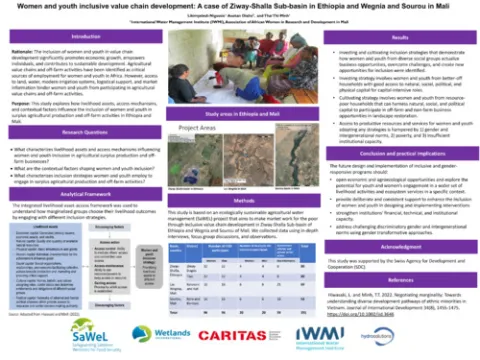Women and youth inclusive value- chain development: A case from Ziway-Shalla sub-basin of Ethiopia and Wegnia and Sourou of Mali

Abstract
Inclusive value-chain development aims to empower small-scale farmers and strengthen the agriculture sector. This study explores the impact of livelihood assets, access strategies, and enabling and discouraging factors on women’s and youth’s inclusion in surplus agricultural production and off-farm activities in Ethiopia and Mali. It is based on an ecologically sustainable agricultural water management project that aims to make markets work for the poor through inclusive value-chain development in Ziway-Shalla Subbasin of Ethiopia and Wegnia and Sourou of Mali. We explored how livelihood assets, strategies for accessing the assets, and enabling and discouraging factors in the value chain shape the inclusion of women and youth in surplus agricultural production and off-farm and nonfarm activities in landscape restoration. A qualitative dataset of 32 focus group discussions, 48 key informant interviews and 40 in-depth interviews was analyzed. We identified investing and cultivating inclusion strategies that demonstrate how women and youth from diverse social groups actualize business opportunities, overcome challenges, and create new opportunities for inclusion. Investing strategies involve women and youth from better-off households with good access to natural, social, political and physical capital for capital-intensive roles. On the other hand, cultivating strategies involve women and youth from resource-poor households that can harness natural, social and political capital to participate in off-farm and nonfarm business opportunities in landscape restoration. However, access to productive resources and services for women and youth adopting any strategies is hampered by gender and intergenerational norms, poverty and insufficient institutional capacity. We argue that it is essential to understand how social disparities and local environments interact to design and implement inclusive value chains. Additionally, it necessitates building competencies in institutions of various sizes.
